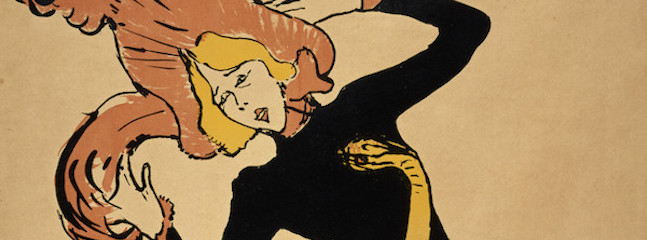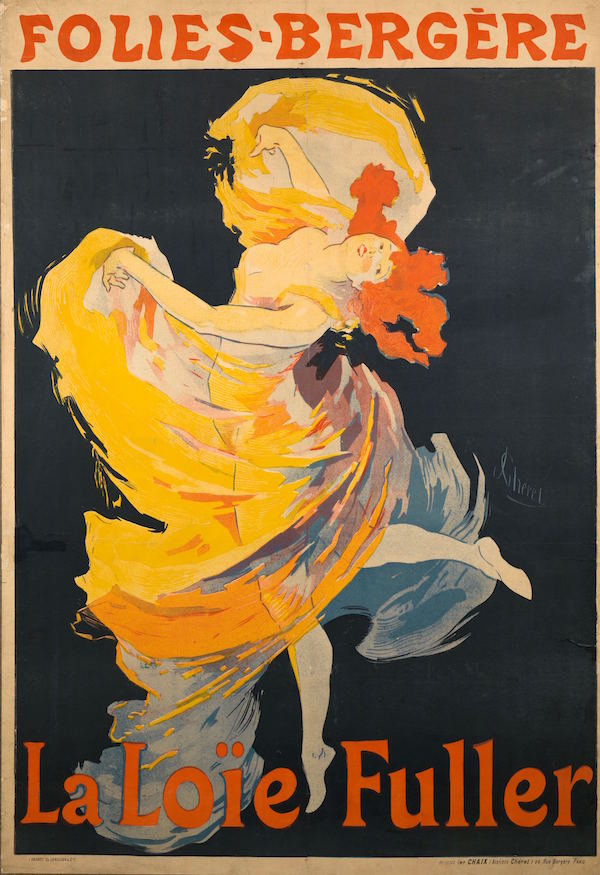
We talk to Hannah Brocklehurst about the work of Toulouse-Lautrec and the exhibition at the National Galleries of Scotland.
When you flick through a magazine or at a billboard, do you realise you're looking at a piece of art? Renowned 1920s artist Henri de Toulouse-Lautrec was part of the poster revolution, transforming advertising from black and white announcements into colourful creations, and breaking down the barriers between high art and popular culture. The Scottish National gallery is exploring this poster pioneer's work in its upcoming exhibition “Pin-ups: Toulouse Lautrec and the Art of Celebrityâ€, so we chatted to curator Hannah Brocklehurst to get the low-down.
Culture Calling: This is the first exhibition held at the National Galleries of Scotland to focus on the work of Toulouse-Lautrec. What made the galleries decide to explore his oeuvre?
Hannah Brocklehurst: We felt it was overdue! When I put the idea forward, people were surprised when it turned out we hadn’t done one before. We wanted to give it a slightly different angle from previous exhibitions elsewhere, because obviously, there’s been a lot of Toulouse-Lautrec exhibitions over the years and even recently. We wanted to explore this idea of celebrity, because it seems pertinent to our times.
_Portrait_of_Toulouse_Lautrec_Aquatint_on_paper_22.4_x_13_.6_cm_Collection:_National_Galleries_of_Scotland_Kenneth_Sanderson_Bequest_1943_.jpeg)
Image Credit: Charles Maurin (1856-1914). Portrait of Toulouse Lautrec. Aquatint on paper 22.4 x 13.6 cm. National Galleries of Scotland, Kenneth Sanderson Bequest 1943.
CC: Within this idea of celebrity, Lautrec often depicts famous female figures. Is that a strong theme of the exhibition, how the artist explores the role of females in his context?
HB: There are a lot of images of women, but there are images of men as well. The focus is more on performers, and there were quite a few male performers and personalities that were a big part of the scene in Montmartre at that time. For example, there’s the famous Aristide Bruant with the scarf over his shoulder. In focusing on Lautrec’s images of the entertainment industry, we haven’t looked at the images he did of women working in brothels, because that’s a different story. They didn’t tie in. They are much more private, whereas we’re looking more at prints that were for publicity purposes. It was the golden age of the poster. Its birth had happened a few decades earlier with the early master of the poster being Jules Chéret who we’ve also got in the show. He pioneered the use of colour, design and image in posters, making them appealing to look at and memorable. Before that they were more like black and white announcements. From that, Lautrec and his contemporaries started to develop this as well, and the poster became an artform.
CC: What do you think is the relationship between art and popular media, and what is the significance of displaying the medium of advertising in a gallery context?
HB: That transition from these being objects that were ephemeral, and intended for advertising purposes actually happened back that. It’s not a reassessment today. Lautrec had a big part in that cross over. It was almost like the birth of graphic design. At that time, there was an old fashioned hierarchy where painting and sculptures were at the top, considered high art, and would have been shown in the academy exhibitions, whereas printmaking would be considered a lower art form. It was seen primarily as a process for reproducing existing images, or more as a decorative rather than high art. But Lautrec and other avant-garde artists weren’t really interested in adhering to the traditional norms of the academies. They didn’t really need them so much anymore. With posters you could get your name out there and be a success without exhibiting in an academy, because you exhibiting essentially on the street.
CC: It was also probably more commercially viable to work for a consumer market!
HB: Exactly. There was money to be made, but they still had artist integrity. This was a breakthrough moment because people started to apply artistic skill to these works. They even got picked up on by critics at the time - there were lots of reviews of posters that were on the streets, or on billboards. So, Toulouse-Lautrec’s first poster, which he made in 1891, established his name instantly, because it was seen by so many people. It caused this sensation, people started to take down his posters and collect them, critics were writing about them, and within a year, copies were included in exhibitions alongside traditional paintings.

Image Credit: Jules Cheret (1836-1932). La Loie Fuller, 1893. Printer: Chaix (Ateilier Cheret), Paris. Lithograph in red, yellow, dark violet, and black ink on paper, 124 x 84cm. Collection: The Hunterian, University of Glasgow.
CC: It’s amazing, because the revolution of mass produced and popular art is often attributed to the 1960s and artists like Andy Warhol, whereas it was happening years before in Paris!
HB: That’s something I need to look into a bit more. Lautrec was a complete popularist like Warhol. He wasn’t snotty about his works being produced in volume. They were not for the intellectuals and the galleries. They were for everybody. And the performers he depicted weren’t exactly pillars of the community either. They were really prominent and famous, but a lot of them were self-made and came from working class backgrounds. So they were popular rather than high art subjects.
CC: Just like Warhol and his soup cans!
HB: I think Warhol does owe a lot to Toulouse Lautrec… and I’m fairly sure he said that.
CC: So back to the exhibition… there’s also work on display by Lautrec’s contemporaries such as Pierre Bonnard, Théophile Alexandre Steinlen and Jules Chéret. How do you think these artists illuminate or contrast Lautrec?
HB: They’ve all got their different take. I wouldn’t say they contrast each other, but you’ll see the same person interpreted by Lautrec, portrayed very differently by Steinlen or Chéret for example. Lautrec had an amazing abiliy to take people’s essence and show the real person, even though he did it with stripped back imagery, he managed to “get them” psychologically. Whereas some of the other poster makers were maybe a little less challenging.
But there are also comparisons, for example Lautrec and Bonnard were both drawing on influences from Japanese woodcut prints. They were all living in the same buoyant, artistic time, where Paris was a cultural leader. The Eiffel Tower was built, the Great Exhibition opened, they got electricity. The middle class was growing, so there were more people with leisure time, which was why the entertainment industry grew. So when you look at pictures now, all the artists are evoking that time.
_Moulin_Rouge_La_Goulue_(Poster)_1891_Colour_lithograph_182.8_x_115_.5cm_Collection:_Victoria_and_Albert_Museum_London_presented_by_Mrs_._J_._T_._Clarke_%C3%82%C2%A9_Victoria_and_Albert_Museum_London_._.jpeg)
Image Credit: Henri de Toulouse-Lautrec (1864-1901). Moulin Rouge, La Goulue (Poster), 1891. Colour lithograph, 182.8 x 115.5cm. Victoria and Albert Museum, London, presented by Mrs. J. T. Clarke. © Victoria and Albert Museum, London.
CC: It’s a very popular era, with many people looking back on it nostalgically as a golden age. And Lautrec has come to be an iconic, embodying force of “Golden 20s” Paris.
HB: Yes. Toulouse Lautrec was a personality or celebrity in himself, then and now. You don’t just know about his art; you know about HIM. He’s synonymous with being out, and partying and drinking, and has become a legend of the decade. Just like the Moulin Rouge has. There’s been a number of films on that subject, and there’s always these little cameos, like all the artists (including Lautrec) that crop up in Midnight in Paris (2011). In some ways, the people that are in Lautrec’s posters, most of the fame they have now is because they were depicted by Lautrec. Ultimately it’s Lautrec that has become the most famous.
CC: And to finish, do you have any personal favourites in the exhibition? Are there any particular highlights?
HB: The one I’m really pleased we got is the Moulin Rouge, La Goulue poster, which is the first poster he ever did. It’s come from the V&A, and it’s really big, it’s made up more than one sheet and a lot of examples don’t have the top. So we really had to work out if we could even get it through the door! It’s so iconic and so important to his story, it’s just brilliant. I’ve got to write an 80-word label text for the exhibition, but you could write a thesis on it. We’ve also got Le Chat Noir, and I’m really excited about bringing that to Edinburgh - I’m already hearing from other people that they can’t wait to see it.

Image Credit: Cabaret du Chat Noir (Poster), 1892. Colour lithograph, 134.5 x 94.7cm. © Victoria and Albert Museum, London.
Pin Ups: Toulouse Lautrec and the Art of Celebrity runs from 6 October until 20 January 2019 at Scottish National Gallery, The Mound, Edinburgh, EH4 2EL.